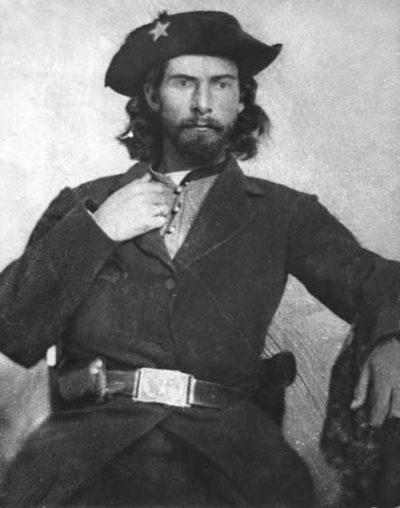William T. Anderson (William T. Anderson)

William T. Anderson (1840 – October 26, 1864), better known as Bloody Bill, was one of the deadliest and most brutal pro-Confederate guerrilla leaders in the American Civil War. Anderson led a band that targeted Union loyalists and Federal soldiers in Missouri and Kansas. Raised by a family of Southerners in Kansas, William Anderson began supporting himself by stealing and selling horses in 1862. After his father was killed by a Union-loyalist judge, Anderson fled Kansas for Missouri. There, he robbed travelers and killed several Union soldiers. In early 1863, Anderson joined Quantrill’s Raiders, a pro-Confederate group of guerrillas that operated in Missouri. He became a skilled bushwhacker, earning the trust of the group’s leaders, William Quantrill and George M. Todd. Anderson’s acts as a guerrilla led the Union to imprison his sisters; after one of them died in custody, Anderson devoted himself to revenge. He took a leading role in the Lawrence Massacre, and later participated in the Battle of Baxter Springs.
In late 1863, while Quantrill’s Raiders spent the winter in Texas, animosity developed between Anderson and Quantrill. Anderson, perhaps falsely, implicated Quantrill in a murder, leading to the latter’s arrest by Confederate authorities. Anderson subsequently returned to Missouri as the leader of a group of raiders and became the most feared guerrilla in the state, killing and robbing dozens of Union soldiers and civilian sympathizers throughout central Missouri. Although Union supporters viewed him as incorrigibly evil, Confederate sympathizers in Missouri saw his actions as justified, possibly owing to their mistreatment by Union forces. In September 1864, he led a raid on Centralia, Missouri. Unexpectedly, they were able to capture a passenger train, the first time Confederate guerrillas had done so. In what became known as the Centralia Massacre, possibly the war’s deadliest and most brutal guerrilla action, his men killed 24 Union soldiers on the train and set an ambush later that day that killed more than 100 Union militiamen. A month later, Anderson was killed in battle. Historians have made disparate appraisals of William T. Anderson: some see him as a sadistic, psychopathic killer, but for others, his actions cannot be separated from the general lawlessness of the time.
Born
- January, 01, 1840
- USA
- Hopkins County, Kentucky
Died
- October, 27, 1864
- USA
- Albany, Missouri
Cause of Death
- gunshot wound
Cemetery
- Pioneer Cemetery
- Richmond, Missouri
- USA


